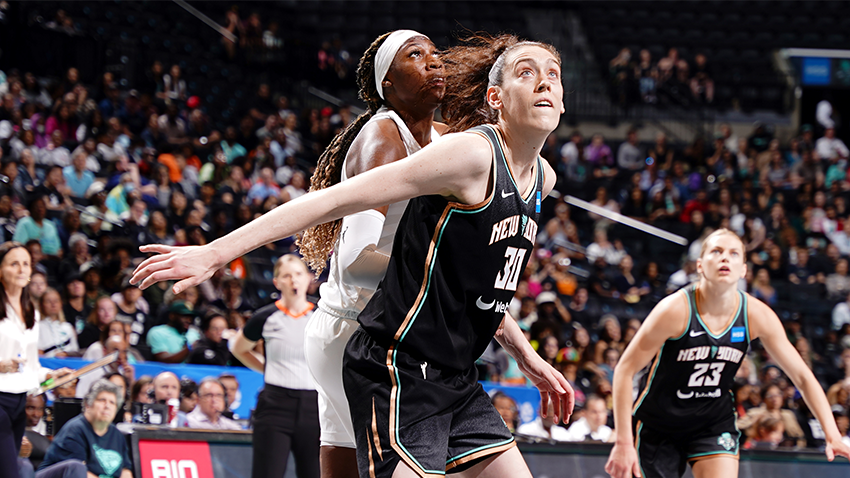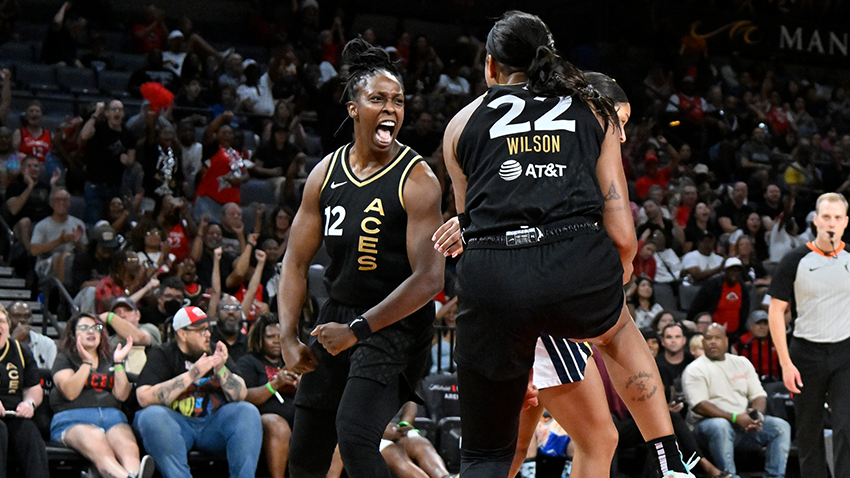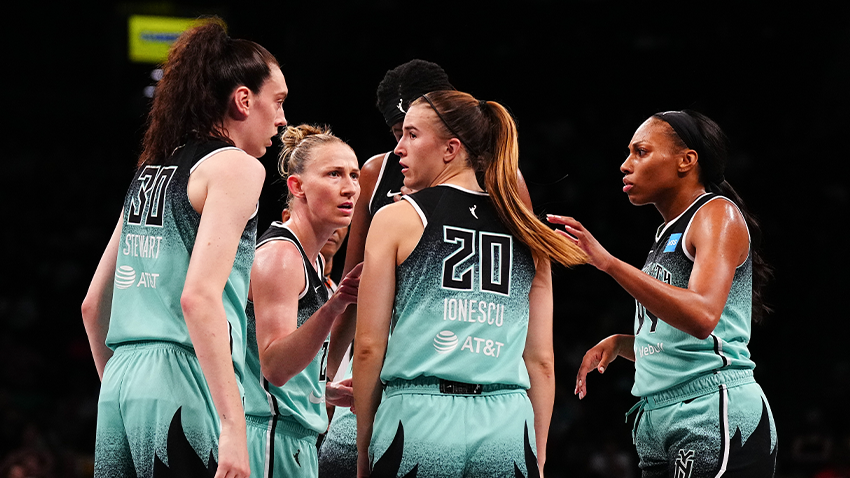Instant Analysis: Assessing Candace Parker's Fit in Las Vegas

It was a remarkably quiet Saturday amidst WNBA Free Agency until it wasn’t as Candace Parker announced her intention to sign with the Las Vegas Aces via her Instagram.
First and foremost, WHOA!!!
It seemed possible that Parker would move on from Chicago, but to see it happen is another thing in its entirety. Then, you dive into the actual on-court impact, and it’s all the more staggering.
I voted A’ja Wilson, Kelsey Plum, and Candace Parker to the All-WNBA teams at the end of the season, with Jackie Young and Chelsea Gray amongst the shortlist that just missed the cut (the voting was mind-bending levels of difficulty). The Aces will deploy a starting lineup of arguably 5 of the 15-20 best players in the sport.
From a sheer talent perspective, this is mesmerizing.
Immediately, I think about what Parker brings to the Aces defensively alongside the reigning Defensive Player of the Year in Wilson. While the Aces were better defensively than their average defensive metrics project, they had some limitations that prevented a higher defensive floor.
They toggled through numerous coverages last season trying to find a base and never fully settled into a primary coverage, opting to change up depending on the matchup. Parker adds a rim protection layer that the Aces didn’t have outside of Wilson.
The duo together can play in softer drops, likely with Parker playing the four and sagging off weaker shooters to muck up the paint. Parker is one of the most mobile bigs in the league, along with Wilson, adding the dynamic of legitimate switchability. She can play closer to the level of the screen in a more aggressive drop. She can show and recover, hard hedge, trap, and absolutely blitz ball screens: Parker can do everything on defense and do it well, and I imagine Wilson takes most of the match-ups with stronger post players.
With two of the best defensive bigs, and the best defenders in the game of basketball, the level of versatility changes for the better. Adding another player who can credibly play the five on both sides of the ball in a positive manner adds another layer of versatility the team lacked last season. Staggering Wilson and Parker while also figuring out their best fits on the floor with one another will be a joy to watch unfold.
Adding another enticing look, along with the Aces bringing in the two-time MVP in Candace, they also bolstered their wing defense, adding the former First Team All-Defense wing in Alysha Clark.
Las Vegas struggled with a lack of wing depth during their title run last season, and now a solid playmaker, shooter, and plus defender will help in that regard. Expect a more robust defense from the Aces, with Parker manning the back line.
Offensively is where things get incredibly interesting!
Figuring out how to make all of that talent cohesive is likely to be a season-long process.
It’s worth noting how differently the Aces and Sky played this past year offensively despite playing with the same goal: create open shots.
Vegas thrived as a ball-screen-heavy team, torching defenses with their pick-and-roll play. The Aces hammered the paint to create open shots either in the paint itself or spraying out to open shooters.
Every player in the Aces’ starting line-up is capable of attacking in isolation when a mismatch presents itself. At times, the offense could slide into stagnancy in a bit of a paradoxical way. All of these players are amongst the elite as shot creators, but ball movement and strong movement within the flow of the offense is vital for creating repeatable, easy looks that impact a defense. These were still good looks, but they could have been better looks that that offense could create with regularity.
The Sky played a motion-heavy offense predicated on the high post and elbow playmaking. Intuitive cutting and heady off-ball play were the staple of Chicago’s title-winning offense and 2021 and in their defending season the following year. Dribble hand-offs, movement shooting, and good screening in East/West actions opened up North/South driving lanes and paint points.
With Parker slotting at the four or five, the opposing team’s stronger rim protectors are typically drawn out of the paint, inverting the floor,” and putting strain on the opposition to make crisp and timely rotations off the ball.
Parker is one of the elite playmakers in the sport’s history, and taking advantage of her blend of size, shooting, handles, and court vision, the Sky put together the league’s second-best offense last season (one that ranks 25th all-time in points per 100 possessions per Her Hoop Stats).
It’s easier said than done to slot in Parker. An offense needs to be built around her to a degree, and rightfully so. How does Parker fit into the equation?
We can get glimpses into potential roles and usage by looking into the past during Parker and Gray’s run with the Los Angeles Sparks. This is a movie we’ve seen before! An award-winning one, at that!
Early offense with Gray and Parker should be a blast, as it was a staple in Los Angeles.
As Parker brings the ball up, Gray hits her own defender with a brush screen as Parker slaloms back towards Gray. Note how the rest of the Sparks have cleared out to the other side of the court, effectively making this an empty corner pick and roll.
This early screen, mixed with the threat of Parker as a driver, creates a defensive hiccup, a moment the offense can capitalize on, and an inherent advantage created against the defense.
Often in defending the Gray/Parker pick and roll, teams would opt to show and recover as defenders went over the ball screen to prevent open threes for Gray.
I’d argue that Parker’s jump-shooting is incredibly vital for that reason, arguably more important now. Parker is still an excellent ball-handler, but she does generate paint touches the same way she used to. In an interview at All-Star this past year, she said she “doesn’t have wheels anymore, before laughing about getting older.
I think she overstated it, but the point stands 63.8% of Parker’s shots last season were jumpers, according to InStat scouting. For reference, 50.2% of Wilson’s shots were. Parker doesn’t quite have the same oomph getting to the rim off the catch, but she also is in that zone where teams will be comfortable letting her gun open shots considering the trade-off that represents as opposed to Chelsea Gray getting into the paint.
It can still be effective, but it’s mitigated.
How Becky Hammon and staff script in secondary actions to work around and exploit defenses for doing so will be a noteworthy storyline throughout the year.
While Nneka Ogwumike and A’ja Wilson are very different players, it’s easy to envision some of the same ideas playing out strategically! The Sparks would often operate out of Horns sets (bigs inwards above the free throw line, wings in the corners: the typical alignment) to draw out opposing bigs before plays began. It wasn’t uncommon to see Chelsea Gray deliver the ball to Parker before wheeling into the paint and curling back to screen for a rolling Ogwumike, who would get a pinpoint pass from Parker for an easy look.
Gray brings that same intrigue, and Plum is one of the best guard screeners in the game.
The big-to-big passing is exciting to think about when picturing the kinds of looks Parker can create for Wilson and vice versa. Every player in the starting five can credibly force defenses to send help, and that should be a terrifying proposition for the rest of the league.
Candace Parker’s addition makes the Aces immediate favorites to repeat, likely regardless of other free agency moves that take place. While nothing is set in stone, watching Las Vegas’ Avengers assemble and find their groove, adding in one of the greatest ever to play the game, will be required nightly viewing.
WNBA reporter Mark Schindler writes a column on WNBA.com throughout the season and can be reached on Twitter at @MG_Schindler. The views on this page do not necessarily reflect the views of the WNBA or its clubs.









,xPosition=.5,yPosition=.5)
,xPosition=.5,yPosition=.5)
,xPosition=.5,yPosition=.5)
,xPosition=.5,yPosition=.5)